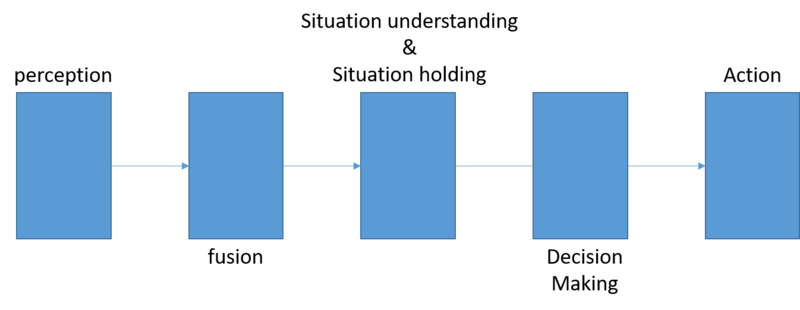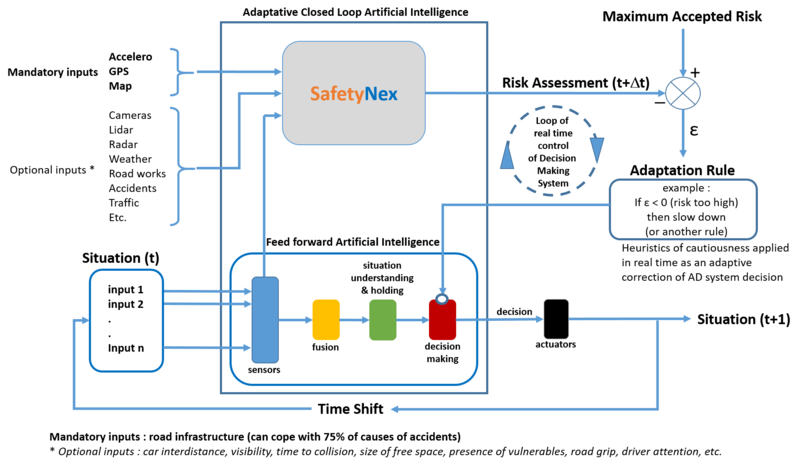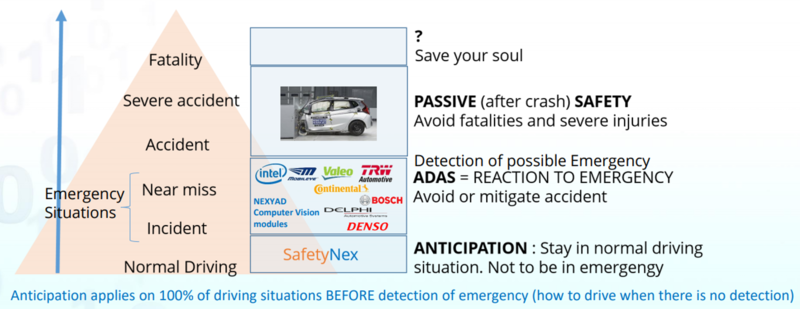An Autonomous Vehicle that drives like a good human driver
An Autonomous Vehicle that drives like a good human driver
Autonomous véhicles are one of the main R&D subject in automotive sector. Autonomoy has been described in a functional way and classified in 6 levels, from 0 to 5.
Today, intelligent cars that are for sale (TESLA, ...) are said to be level 3, and some car munifacturers claim that they have demo cars with a level 4.
The chain of the Autonomous Driving System (AD System) is quite always a feed forward chain, from sensors to actuators, and applies or may apply Artificial Intelligence algorithms and modules :
If such a chain is level 3, how can it be updated to level 5 ? It is very simple, for a feed forward chain, if you want it to be robust (enough good response to quite "any" input), then the only solution is that EVERY box of the chain is quite perfect and provides the right output to quite any input. There is no other solution for a feed forward chain.
Then, measuring the distance between what we do today ("number" of use cases that we do not process properly, etc), some prospective people deduct :
. number of km to be tested (millions of billions)
. power of computers to run improved versions of boxes
All those deductions make them think that personal vehicle will not be autonomous (level 5) before 2030.
The solution we present in this article is very simple : switch from a feed forward loop to a feedback loop. Everyone in the technical and scientifical world knows that this makes the system inherently adaptive to inputs variations, and then much more robust than a feedback chain. Inded, a feedback control slf-corrects the output in order to minimize an error. Then if the feedback chain failed to produce the correct output, then the feedback control will compute an "error" and will iteratively adjust in order to suppress or minimize this error.
Pure feedback control is very lean in terms of sensors of computing but it can apply only after the error is computed. It is then slower than a feed forward chain that would give directly the correct output all the time. But as we exposed above, the cost of such a solution tends to infinite.
The question is : how to compute an error for the AD System ?
The company NEXYAD proposed to use their technology SafetyNex : SafetyNex computes in real time at every moment, the driving risk that the driver is currently taking. If driver is a human being, it is possible to send a vocal alert in case of risk rising, and it has been shown that such a simple solution reduces accident rate at least by 20%. If driver is an AD system then it means that AD system can be "aware" of the risk it is currently taking.
NEXYAD proposed the feed forward chain :
One can see that error is the difference between computed driving risk (computed by SafetyNex) and maximum accepted risk.
This solution is under integration in several demo cars in the world (Tier One Companies and Car Manufacturers) in order to study its robustness.
First results are stunning even when only mandatory inputs are used for SafetyNex. Indeed, minimizing the driving risk means by definition applying cautiousness rules in driving trying never be surprised by an emergency situation. This is called ANTICIPATION.
As shown below, there is a huge difference between reaction to emergency (domain of Advanced Driver Assistance Systems ADAS), and anticipation :
Anticipation is very efficient at low cost because it applies on EVERY driving situation where :
. ADAS apply only in case of detected emergency situation : rare
. PASSIVE SAFETY apply only in case if crash : very rare
Of course, in pratice, the idea is to cumulate anticipation, ADAS, and passive safety. Note : it is interesting to notice that for technical reasons, development was made from passive safety to ADAS, and now to anticipation.
And the better the feedforward chain the best, because a poor feedforward chain would lead to very big errors that may be long to adjust in order to minimize error : the better the feedforward chain the quickest the AD system is and in real time it is very interesting to be fast.
As a conclusion, we can say that all the good work that has been made by engineering teams worldwide to get level 3 feedforward chain can now be robustified by SafetyNex uning the NEXYAD figure.
We will give news of demo car of our customers when authorized.
Such a car natively applies cautiousness rules and can pass the driving licence even in dense urban areas or in the countryside. We can say then that an AD system can drive like a good human driver.
Anf no complexification of feedforward chain : so it may be ready much BEFORE 2030 !!!!





/http%3A%2F%2Fwww.eetasia.com%2Fwp-content%2Fuploads%2Fsites%2F2%2F2020%2F10%2FAV-software-driver-1.jpg%3Fw%3D1024)
/http%3A%2F%2Fwww.geektime.com%2Fcontent%2Fimages%2F2020%2F10%2FMichael-Dick--Nathaniel-Meron--Issak-Davidovich.JPG)
/http%3A%2F%2Ffilter.aimotive.com%2Fpublic%2Fupload%2Fimages%2Faim_linkedin_post_teslafsd_test.jpg)
/https%3A%2F%2Fassets.over-blog.com%2Ft%2Fcedistic%2Fcamera.png)
